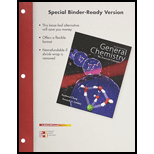
(a)
Interpretation: The angle between
Concept Introduction:
Bond angle:
Bond angle is the angle between two bonds in a molecule and it is determined based on the geometry a molecule.
Molecular geometry
Molecular geometry is based on the arrangement of electron pairs around the central atom. In VSEPR theory, the geometry of a molecule is explained based on the electrostatic repulsion between the lone pairs and bond pairs of electrons surrounding the central atom of the molecule.
Hybridization is the phenomenon of intermixing of the atomic orbitals of different energy that results in the formation of a new set of hybrid orbitals which have equivalent energies. The various types of atomic orbitals are: s, p, and d orbitals. Types of hybridization that involves s, p and d orbitals are
The following table is the tabulation of important hybridizations and the bond angles:
| Hybridization | Molecular geometry | Bond angle |
| Linear | ||
| Trigonal planar | ||
| Tetrahedral |
(b)
Interpretation: The angle between
Concept Introduction:
Bond angle:
Bond angle is the angle between two bonds in a molecule and it is determined based on the geometry a molecule.
Molecular geometry
Molecular geometry is based on the arrangement of electron pairs around the central atom. In VSEPR theory, the geometry of a molecule is explained based on the electrostatic repulsion between the lone pairs and bond pairs of electrons surrounding the central atom of the molecule.
Hybridization is the phenomenon of intermixing of the atomic orbitals of different energy that results in the formation of a new set of hybrid orbitals which have equivalent energies. The various types of atomic orbitals are: s, p, and d orbitals. Types of hybridization that involves s, p and d orbitals are
‘
The following table is the tabulation of important hybridizations and the bond angles:
| Hybridization | Molecular geometry | Bond angle |
| Linear | ||
| Trigonal planar | ||
| Tetrahedral |
(c)
Interpretation: The angle between
Concept Introduction:
Bond angle:
Bond angle is the angle between two bonds in a molecule and it is determined based on the geometry a molecule.
Molecular geometry
Molecular geometry is based on the arrangement of electron pairs around the central atom. In VSEPR theory, the geometry of a molecule is explained based on the electrostatic repulsion between the lone pairs and bond pairs of electrons surrounding the central atom of the molecule.
Hybridization is the phenomenon of intermixing of the atomic orbitals of different energy that results in the formation of a new set of hybrid orbitals which have equivalent energies. The various types of atomic orbitals are: s, p, and d orbitals. Types of hybridization that involves s, p and d orbitals are
The following table is the tabulation of important hybridizations and the bond angles:
| Hybridization | Molecular geometry | Bond angle |
| Linear | ||
| Trigonal planar | ||
| Tetrahedral |
Want to see the full answer?
Check out a sample textbook solution
Chapter 10 Solutions
Loose Leaf Version for Chemistry
 ChemistryChemistryISBN:9781305957404Author:Steven S. Zumdahl, Susan A. Zumdahl, Donald J. DeCostePublisher:Cengage Learning
ChemistryChemistryISBN:9781305957404Author:Steven S. Zumdahl, Susan A. Zumdahl, Donald J. DeCostePublisher:Cengage Learning ChemistryChemistryISBN:9781259911156Author:Raymond Chang Dr., Jason Overby ProfessorPublisher:McGraw-Hill Education
ChemistryChemistryISBN:9781259911156Author:Raymond Chang Dr., Jason Overby ProfessorPublisher:McGraw-Hill Education Principles of Instrumental AnalysisChemistryISBN:9781305577213Author:Douglas A. Skoog, F. James Holler, Stanley R. CrouchPublisher:Cengage Learning
Principles of Instrumental AnalysisChemistryISBN:9781305577213Author:Douglas A. Skoog, F. James Holler, Stanley R. CrouchPublisher:Cengage Learning Organic ChemistryChemistryISBN:9780078021558Author:Janice Gorzynski Smith Dr.Publisher:McGraw-Hill Education
Organic ChemistryChemistryISBN:9780078021558Author:Janice Gorzynski Smith Dr.Publisher:McGraw-Hill Education Chemistry: Principles and ReactionsChemistryISBN:9781305079373Author:William L. Masterton, Cecile N. HurleyPublisher:Cengage Learning
Chemistry: Principles and ReactionsChemistryISBN:9781305079373Author:William L. Masterton, Cecile N. HurleyPublisher:Cengage Learning Elementary Principles of Chemical Processes, Bind...ChemistryISBN:9781118431221Author:Richard M. Felder, Ronald W. Rousseau, Lisa G. BullardPublisher:WILEY
Elementary Principles of Chemical Processes, Bind...ChemistryISBN:9781118431221Author:Richard M. Felder, Ronald W. Rousseau, Lisa G. BullardPublisher:WILEY





